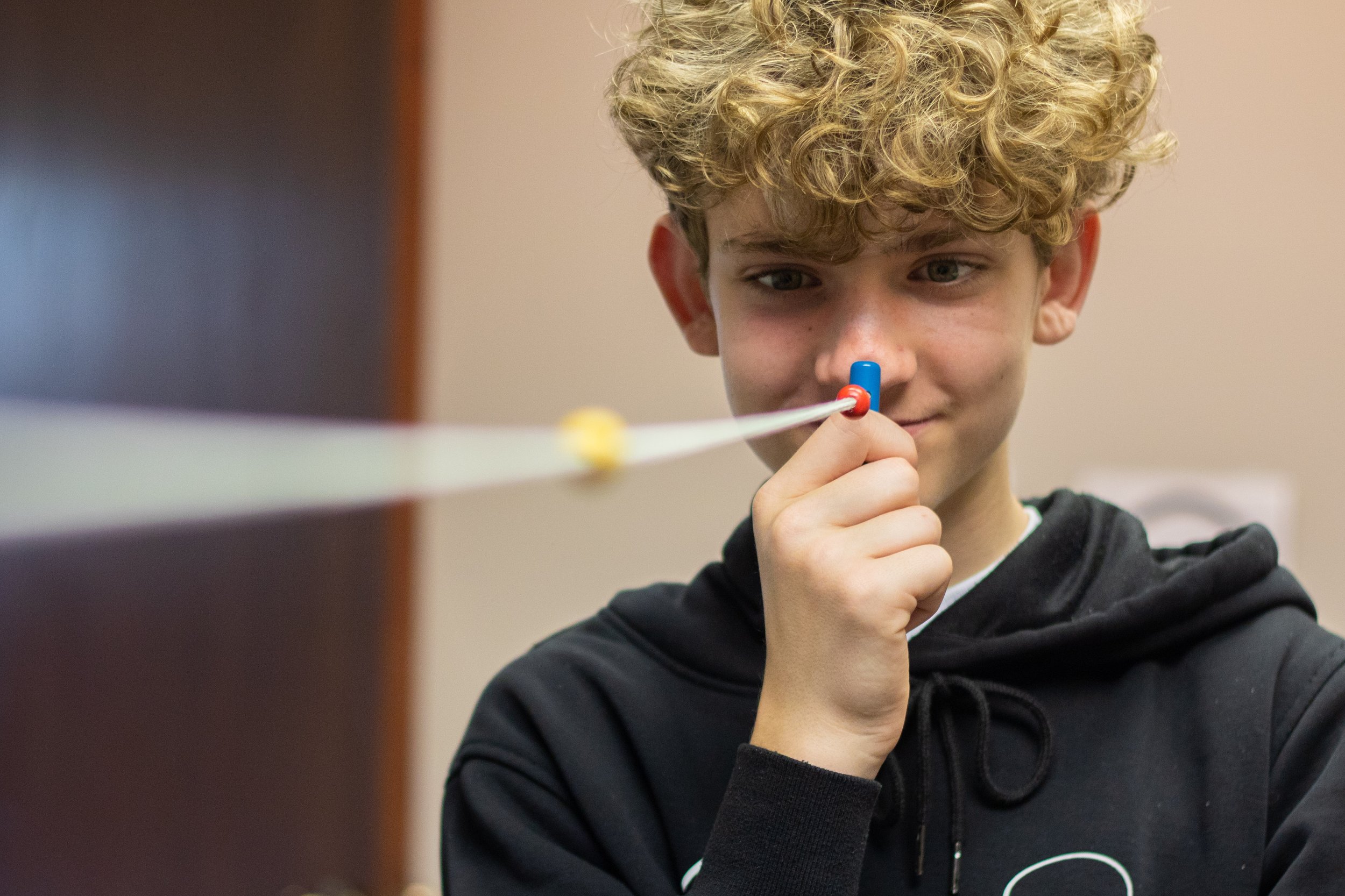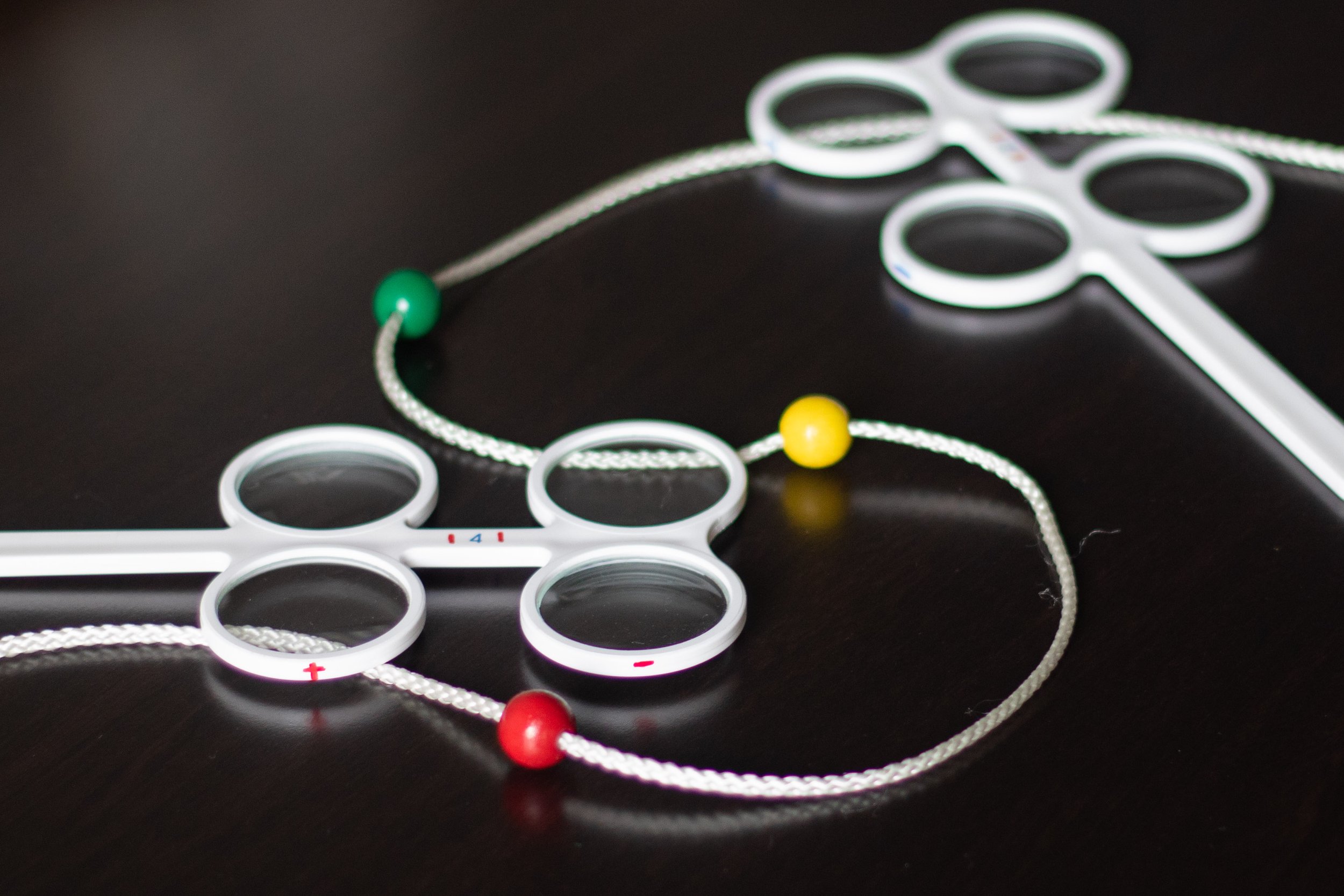
Frequently Asked Questions
What is Vision Therapy?
Vision therapy is a treatment to address vision problems like eye teaming, eye focusing, tracking (such as a ball or a words on a page), reading eye movements, depth perception, visual information processing, and visual motor integration, to name a few. An individualized treatment plan is created to address the problem areas which includes activities that are often fun and age-appropriate, and build off each other from week to week. In most cases it takes on average 6 to 12 months to retrain the brain on how to accurately and efficiently use vision to function better in school, sports, and life. Typically we recommend one office appointment per week lasting one hour, plus 20-30 minutes of daily home activities to reinforce the skills that were learned in the office. Every 12 weeks, your developmental optometrist will complete progress evaluations with each patient to confirm that we are continually making progress and finally ready to graduate!
Are these vision problems common?
Studies show about 1 in 4 children have a vision problem that interferes with their ability to read, learn, comprehend, and pay attention. Studies also show these rates are much higher in children diagnosed with ADD, ADHD, dyslexia, and learning disabilities.
Unfortunately, these problems are often undiagnosed because most vision screenings and eye exams only check for 20/20 eyesight far away, and ignore how that child’s eyes function where they spend most of their day – looking up close!
Convergence Insufficiency is 3x more common in individuals with ADHD, making it harder to focus on reading.
Functional vision problems are found in 80% of those with Dyslexia.
90% of Concussion patients have a functional vision problem.
Will the progress of Vision Therapy wear off or regress?
In most cases, no. The beauty of vision therapy is that once the brain learns how to gather and process visual information more accurately and efficiently, it does not regress back to old and ineffective bad habits. The difference between an eye problem and a vision problem is that while most of our patients’ eyes work fine, the brain has not developed the visual skills to use their eyes productively. A common misconception is that vision therapy is strengthening eye muscles. As we change the way the brain uses the eyes, vision is learned and developed. Similar to riding a bike, these skills go into motor memory and learning, and are not forgotten!
In the case of a concussion or traumatic brain injury, many patients lose visual skills that they previously had properly developed. This can be extremely frustrating and debilitating for school, sports, work, or driving. Vision rehabilitation follows a similar concept as above where the brain needs to re-learn how to use vision. Our goal is to get your eyes back to normal or as close to normal as possible and accelerate the healing so you can return to work and normal life as quickly as possible.
After graduating from vision therapy, we include re-evaluations one and three months to confirm that there is no regression in skills. Vision therapy is a one-time financial and time investment designed to last and pay dividends for a lifetime.
Is Vision Therapy covered by insurance?
Sometimes. Medical insurance companies often view these vision problems as a learning issue, not medical. Some companies will cover a portion of therapy; however, every insurance company is different.
We do not participate with insurance, so as to not let these companies dictate whether you or your child get the care that is necessary. Our independence from medical insurance allows us to invest in the best possible technology and training for our premium vision care program.
We can provide the necessary codes and receipts for you to file claims, as well as a letter of medical necessity. We also provide a script for the proper questions to ask your insurance company on what coverage you have and how to submit insurance claims. You may receive reimbursements from your medical insurance company after paying out of pocket.
Will Vision Therapy cure ADD or ADHD?
Although it does not cure it, many times there is a vision problem that mimics or complicates attention problems. If it is uncomfortable for their eyes to focus up close, children can get frustrated with schoolwork, avoid near work, and act out to get away from reading. After vision therapy, we have seen children taken off their medication, have the dosage reduced, or they are significantly more successful with their necessary medication.
Some common signs that indicate is vision problem is at play include:
Loses concentration on difficult near vision work like reading but can focus on something more fun like a video game or sports
Restless, irritable, and short attention span with reading
Disturbs others in class
Compelled to touch everything
Bumps into things, trips, falls, unaware of surroundings
Hates to read, but likes to be read to
Learning problems continue, even after starting medication
Does Vision Therapy treat Dyslexia?
True developmental dyslexia is a disorder of language processing. 80% of patients with dyslexia also have binocular vision dysfunctions impairing their eyes ability to work together as a team, focus, and track across the page. Vision therapy will treat these vision problems to resolve symptoms such as double vision, blurry vision, letters “swimming” or moving around, letters jumbled together, and letter/number/word reversals. When these problems are taken care of, dyslexia is easier to overcome.
80% of People with Dyslexia also have:
Convergence Insufficiency - difficulty coordinating both eyes onto page. Symptoms include double vision, eyestrain, headaches, and more
Accommodative Dysfunction - difficulty focusing eyes onto page. Symptoms include blurry vision, eyestrain, headaches, and more
Oculomotor Dysfunction - difficulty tracking eyes across the page, causing skipping, repeating, losing place, need to re-read for comprehension
Many of our patients have been told they have dyslexia, only to see all dyslexia symptoms go away after vision therapy. The vision problems we treat often mimic or complicate dyslexia. When the problem is actually vision, we can take care of the real issue and allow that child or adult to see the page just like they’re supposed to!
How thorough is the evaluation process?
Although our evaluation process includes everything that a standard eye exam tests, like distance acuity, prescription, and ocular health, it is much more comprehensive. We spend up to 3 hours with the patient evaluating every visual skill that is essential to learning, reading, comprehending, paying attention, playing sports, and functioning in every day life. We determine every diagnosis and the severity to determine if that patient needs a treatment program, how long of a treatment program is necessary, and if therapeutic lenses would be beneficial. Our evaluation includes:
distance and near visual acuity (sharpness or clarity of vision, 20/20 far away)
eye alignment
convergence (eye teaming/working together)
accommodation (eye focusing when switching from near to far or far to near)
eye movements including saccades, pursuits, and fixation (tracking moving objects and moving eyes along a page to read)
stereopsis (depth perception, 3-D vision)
binocularity (use of both eyes together)
visual-vestibular integration (eyes “see” what the inner ear “feels”, motion sickness)
balance
spatial awareness
peripheral awareness
visual motor integration (eye-hand coordination)
visual memory
figure-ground (filter out irrelevant visual information to concentrate on what is important)
visual discrimination
visual closure (recognizing an object when only a portion is visible)
form constancy (understanding that an object stays the same even when it changes its size, position or is in a different environment)
ocular health (eye health)
Can Vision Therapy fix an eye turn?
Yes, it can, or at least improve. Strabismus, also called eye turn or crossed eyes, is the result of an inability of the brain to use two eyes together. Your brain takes visual information from two eyes and has to make those two images appear as one. If any stage in the visual development process is delayed or asymmetric, a compensatory response would be to turn one eye so far in or out that the brain could ignore the information from that eye.
1 in 20 people have strabismus. This means there is at least one child suffering from this condition in every classroom.
Vision therapy retrains the brain to use both eyes together. This is challenging and takes time to break down the preference to use one eye. Through vision therapy, the patient’s brain gradually understands the benefits of using both eyes together to achieve depth perception and binocular vision (eyes working together as a team).
Thanks to modern research on neuroplasticity and the brain’s ability to modify and change, it is never too late to make progress and seek treatment!
Will vision therapy help a lazy eye? Is it different from patching?
Amblyopia, also called lazy eye, is a condition where one eye has a reduced ability to see, compared to the other eye. People can also have bilateral amblyopia where both eyes see poorly. The amblyopic eye is unable to see 20/20 even with glasses. Research also shows that the amblyopic eye also has reduced visual skills like focusing, teaming, tracking, contrast sensitivity, and perceptual processing. Amblyopia can also cause deficits in both eyes as well, like suppression of binocular vision and poor depth perception.
Vision therapy works to address all of these issues in amblyopia. Our goal is to make the amblyopic eye just as strong as the better-seeing eye, plus make both eyes work together as a team to develop depth perception and binocular vision.
The traditional treatment is patching the good eye to help force the amblyopic eye to work. This is helpful for one-eye skills like visual acuity but does not address two-eye processing in the brain to develop binocular vision and depth perception. So, it’s not that patching is bad. It’s just that vision therapy is better.
Can a concussion damage your vision?
A mild traumatic brain injury (concussion) can cause a loss of previously developed visual skills. Vision problems occur in 90% of concussions because visual processing is so dominant in neurological activity. It is estimated 40% of the brain is visual machinery that is prone to dysfunction with a brain injury. Most people with a concussion are still able to see 20/20 far away, but suffer from visual symptoms like headaches and eyestrain while reading, visual fatigue, dizziness, light sensitivity, visual motion sensitivity, peripheral vision and depth perception issues, as well as poor visual memory, among others.

